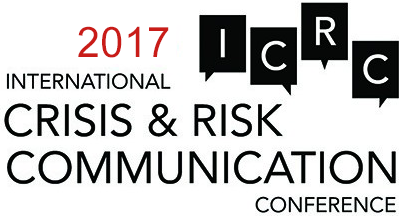
Professor
University of Kentucky
United States
Timothy L. Sellnow (Ph.D.) is Professor of Communication and Information Science at the University of Kentucky. His primary research and teaching focus is on risk and crisis communication. Much of his recent research focuses on comprehension of risk messages and strategic communication for mitigating the impact of and maintaining resilience in response to crises. He has co-authored five books and published many refereed journal articles focusing on strategies for effective risk and crisis communication. His most recent book, co-authored with Matthew Seeger, is entitled, Theorizing Crisis Communication. He is also a past editor of the Journal of Applied Communication Research. He has served as a risk and crisis communication advisor for the Centers for Disease Control and Prevention, The World Health Organization, National Academy of Sciences, United States Geological Survey, and the United State Department of Agriculture.
2015
Effective Crisis and Risk Communication Message Design:
Considering Ecological Validity
Deanna D. Sellnow and Timothy L. Sellnow
College of Communication and Information
University of Kentucky
Although internal and external validity are critical to any high quality social scientific research study, we argue that ecological validity is equally important when formulating and testing crisis and risk communication messages. To achieve ecological validity, the methods, materials, and setting must be representative of the real-world crisis or risk situation being examined. When designing and testing instructional crisis and risk messages intended to achieve affective, cognitive, and behavioral learning, we contend that ecological validity ought to be addressed from the outset, that is, when designing messages and measurement tools. In this session, we illustrate how we attempted to accomplish ecological validity by describing the participatory processes we employed in two funded research projects. First, we invited participation from food scientists, professional television news broadcasters, and communication experts when designing mock television news stories intended to empower receivers to make informed choices for self-protection regarding tainted food products. Second, we facilitated a design storm involving seismologists, emergency managers, engineers, graphic designers, and communication experts to develop earthquake early warning messages delivered via a phone app. Through this participatory approach, these projects more closely emulate real-life crisis and risk communication challenges and allow for more valid measurement of audience perceptions.
2014
General Session: Urgent Crisis Communication: Designing Effective Earthquake Warning Messages*
In high risk and crisis situations, receiving the right message at the right time can save lives. Natural disasters certainly qualify as crisis events. Few natural disasters are more constrained by short response time for warning potential victims as earthquakes. Once an earthquake begins, officials often have only a few seconds or minutes to warn people and communities located near the quake’s epicenter that potentially deadly shaking is going to begin and provide instructions for self-protection. To meet this challenge, the United States Geological Survey turned to crisis communication experts and visual communication specialists to design effective early warning messages that can be delivered via a smart phone APP. Given the extremely short time span available to get earthquake warning messages out, such messages must be immediately recognizable, tailored appropriately, and clearly instructive in terms of self-protection.
This project faces several constraints inherent in many crisis contexts. For example, sharing probabilities to help people comprehend their level of risk is constrained by a wide disparity in how probabilities are interpreted. Moreover, disparate levels of risk science literacy and number sense literacy among people and groups create comprehension disparity constraints. Still another constraint stems from the fact that we live in a world where a worried public demands certainty about scientific information regarding potential crises that cannot be fully comprehended. Those charged with communicating early warning messages about earthquakes are challenged by these constraints. This project seeks to address these constraints by merging instructional risk and crisis communication literature and visual design techniques with seismology science information to create, test, and improve early warning and operational forecasting messages about earthquakes. Ultimately, designing and implementing effective instructional risk and crisis communication messages about earthquakes has the potential to save lives.
The presentation proposed will describe how Sellnow and Sellnow have addressed these constraints in developing early warning messages for this project. They will also share sample messages and provide statistical results of their initial round of message testing. Finally, they will generalize beyond our project to include a discussion of practical applications for addressing the consistent constraints of creating warning messages in crisis contexts.
*Timothy Sellnow and Deanna Sellnow co-authored this paper. Timothy Sellnow and Deanna Sellnow will present.


